Do You Have to Winterize an Outboard Motor? (2-Stroke vs. 4-Stroke)
Outboards are simple, right? Those used on sailboats as auxiliary power are small; larger than 15 HP is unusual, and smaller is more common. There are two types of outboard engines: 2-stroke, which are lighter and more powerful, and 4-stroke, which are more fuel-efficient and produce fewer emissions. When winter approaches and you won't be using your boat anymore, do you have to winterize an outboard motor?
If you want your engine to start in the spring and last you many years and plan on not using your engine all winter, you do have to winterize an outboard motor. Winterizing the engine helps to prevent damage during disuse, which is the chief cause of engine failure. Failing to winterize may lead to complications.
It's more about the long period of disuse than the winter. Don't worry, though; it's not complex. You can do it in your driveway in a couple of hours and rest easy for the winter.
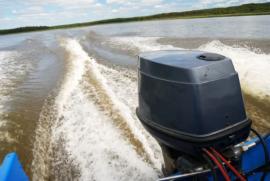
How to Winterize an Outboard Motor (2-vs-4-Stroke)
Summary
- It's important to winterize your outboard motor before storing your boat for the winter to prevent damage from freezing temperatures and corrosion.
- The winterization process for outboard motors involves draining the engine of any water, changing the oil and oil filter, adding a fuel stabilizer to the gas tank, and removing the battery.
- It's important to follow the manufacturer's instructions for winterizing your specific outboard motor and to store it in a dry, cool place to prevent damage.
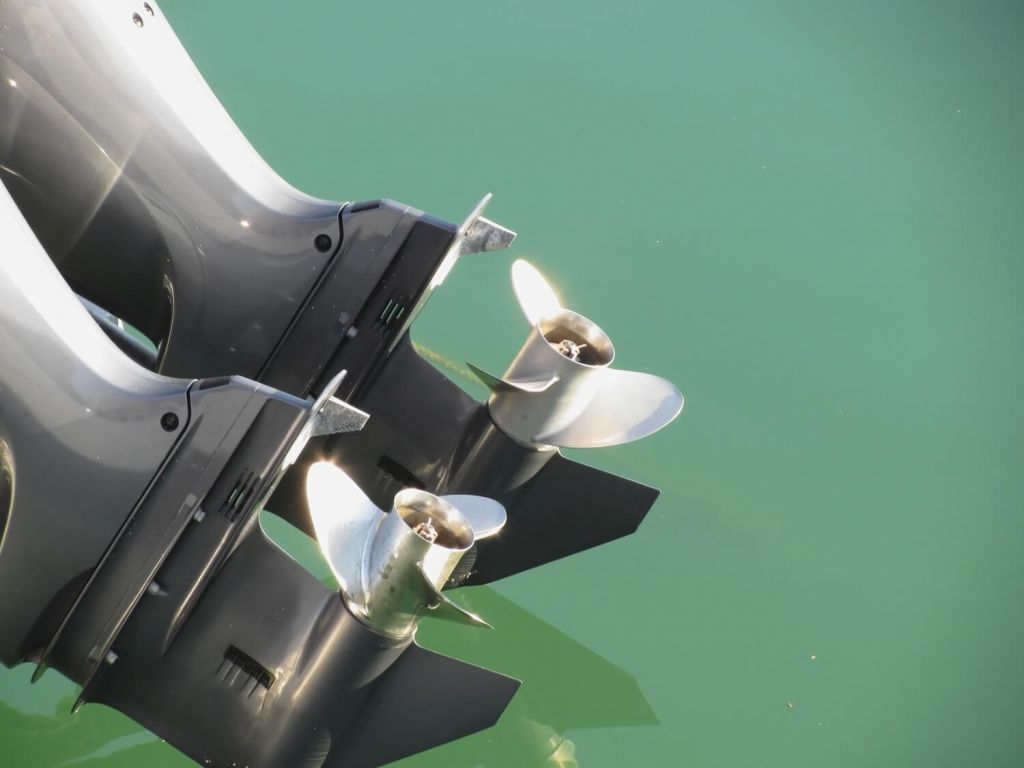
On this page:
You Have to Winterize a 4-Stroke Outboard Motor
Even though 4-stroke engines are more fuel-efficient and produce fewer emissions than 2-stroke engines, they still require winterization to prevent damage from freezing temperatures.
The process of winterizing a 4-stroke outboard motor involves draining the engine of any water, changing the oil and oil filter, and adding a fuel stabilizer to the gas tank. It's also important to remove the battery and store it in a dry, cool place.
You Have to Winterize a 2-Stroke Outboard Motor
2-Stroke engines are known for their power and lightweight design, but they require more maintenance than 4-stroke engines.
To winterize a 2-stroke outboard motor, you need to add a fuel stabilizer to the gas tank, fog the engine with fogging oil, and remove the spark plugs to spray fogging oil into the cylinders. It's also important to drain the lower unit gear oil and replace it with fresh oil. Finally, remove the battery and store it in a dry, cool place.
What if you don't winterize?
Even if cold weather isn't the major risk your engine is facing, any outboard that won't be used for a long time should be prepared for a layup. What you are trying to avoid is corrosion, buildup, old fuel, and rust. A tall sawhorse or an outboard carrying bracket is handy for these jobs if you take the engine off the boat for storage.
In the worst-case scenario, if you don't winterize your boat and store it at below-freezing temperatures, water left inside engine cavities can freeze and expand, cracking parts of the engine. Even if you store it in a garage or basement, old fuel left in the engine can gunk up carburetors and not burn well when you start in the spring. Dirty oil with acidic deposits can damage metal components, and salt left inside cooling and circulation chambers can cause buildup or corrosion. Or both.
So even if you plan to store your outboard on a sawhorse in your well-heated kitchen for the winter, take a few minimum steps to prepare the engine for the long layup. (Don't ask...my wife has never forgotten this. I told her I needed a shed...)
I've previously written an entire list of reasons why it's important to winterize your boat and what will happen if you don't.
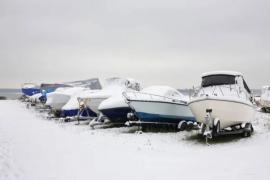
Winterize Your Boat
What if I'm Going to Use My Boat?
Some sailors say there is no such thing as bad weather, only inappropriate clothing. If you live somewhere with year-round sailing or winters mild enough to sail wearing warm clothing, you have a few different considerations.
We used to sail lasers until our cove froze over in January, and some small powerboats were still in the water for safety. But when the cove froze, we were done. Even if you use your boat for part of the winter, when you are done with the season, you should prepare it for storage for the rest of the winter.
What's Different When I Use It?
Most of the "winterizing" procedures are "long term storage" procedures to protect the engine from disuse. It's not like winterizing a fresh water system or large block engine; you're fighting corrosion and gunk buildup more than freezing, expansion cracking, and breaking.
So if your outboard will see regular use throughout the winter, you don't have any extra risk for it since you will use the fuel, circulate the oil, and regularly heat the engine up. You need to watch the weather, but you need not perform any special tasks before or after using the engine in the winter.
Freezing risks
If the water isn't frozen, you can run your outboard into it. But if you leave your engine in the water and the water freezes, it can suffer damage. You shouldn't leave your prop in the water anyway because it will build up growth and wear away the anodes, but the winter is riskier if there’s a big cold snap.
Engines in the tilted-up position do not drain all the water from the jacket the way an engine in the upright position does. So take care if you do have a freezing risk; check the engine and take it off the boat to drain if you can't drain it in place.

Here's What Happens If You Don't Winterize
What About Antifreeze?
Do you need antifreeze to winterize an outboard? Not really, no. Unlike the big auxiliary engine in a boat, the raw water jackets on an outboard will drain with the engine in an upright position. If you've flushed your engine with salt water, the fresh water will drain out if you leave the engine upright on a sawhorse or a stand. If you plan to store it on a stand, you can't even keep antifreeze in the jacket without blocking some outlet holes (not recommended). Though there is no harm in flushing with antifreeze, it's not generally needed.
If you plan to store the engine in a position other than straight up, such as on its side or up in the out-of-water tilt position, make sure you've let it stand for a day or two for the water to drain out of it before you store it.
Any engine stored indoors where the temperature will never drop below freezing does not need antifreeze.
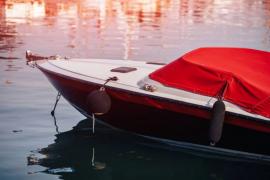
Do This Now If You Didn't Winterize Your Boat
What Are the Steps to Winterize?
We have created an entire checklist for boat winterization (pdf), which you can download for free in this article.
Note that these steps are not in order, as several of them can and should be done at the same time. For example, you can flush the engine, run out the fuel, and fog it all at once, and you should run the engine to warm it before you change the oil.
-
Rinse and clean the engine. Clean and flush the outside of the outboard well. Make sure you knock off all the salt and as much of the dirt and accumulated crud from the season as you can. A wipe with a rag will take off more grime, if it's the oily sort.
-
Drain the fuel or run it out. Fuel sitting in a carburetor bowl for a long period will cause gumming and deposits, and in lines, it may block delicate jets. In North America and places where ethanol is added to fuel, the alcohol in the gas encourages the absorption of water. Either drain the carburetor if it has a drain screw, or start the engine with the fuel line disconnected and let it run until it stops. You can do this on an engine stand or sawhorse, and at the same time, you're flushing the engine.
-
Flush the engine with fresh water. Using an outboard flusher (or "earmuffs," as some call them), put them over the raw water intake of the engine and connect a hose. Turn on the water and start the engine. Let it run long enough to flush a fair amount of fresh water through the system to clear the salt. Additional de-salting or de-scaling products are not usually needed at this step, at least on smaller or newer engines. Larger outboards may have flushing ports built in.
-
Change the engine oil. For four-stroke engines, change the engine block oil. Changing it at the end of the season ensures you don't leave dirty oil - which may have acids and contaminants - in contact with internal engine parts. You may drain the oil and leave it empty if you prefer, but make a clear note for yourself so you remember to fill it in the spring. Starting the engine without oil will quickly destroy it. To avoid this terrible mistake, I recommend putting clean oil in when you winterize just to be safe.
-
Change the lower unit oil. Did you know there's another oil reservoir down in the engine's lower unit that needs to be changed, even in a two-stroke? I didn't, not until I'd owned boats for a few years. It pays to read the manuals, especially if you're doing your own work. The end of the season is a good time to change the lower unit oil, for much the same reason as changing the engine oil. Though lower unit oil doesn't get exhaust byproducts mixed into it like engine oil does, it still gets dirty. You don't want any particulate matter grinding in your gears in the spring. Lower unit oil is thicker than engine oil and requires a special grade. It will be labeled accordingly; consult your owner's manual.
-
Fog the engine with oil. Fogging the engine with a fine layer of special oil will prevent rust and corrosion while the engine sits. A spray can of fogging oil will last you a long time with a small engine and is available at any marine chandlery.
-
Stabilize or dispose of your fuel. If you have a large quantity of fuel at the end of the season, you can use a fuel stabilizer to keep your fuel from spoiling over the winter. Since most small outboards rarely have fuel tanks larger than six gallons, this may be more work and expense than it is worth. When I had four-stroke outboards, I just got a funnel and drained the remnants into my car or disposed of them at a marina. Don’t put two stroke pre-mixed oil in your car. Most marinas and gas stations have waste fuel facilities, though there may be a nominal charge if you don't store your boat there.

Do I Need to Winterize an Indoor Stored Boat?
Did you find the answer to your specific question?
👍 9 👎 2

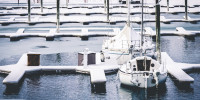

Comments
Amy Saunders
Wow, I never knew that we can protect our motor engine from corrosion by applying a thin layer of special oil on it. It’s been a while since my father-in-law last used his motorboat and he wants to use it during the winter. I guess he should send it for a maintenance very soon. http://www.allseasonshonda.net/outboards
Amy Saunders
Hi there! It’s me again. I just couldn’t stop thinking about your article, especially when you pointed out that we should keep our carburetor bowl empty during winter to avoid any long-term damage. My father-in-law wants to use his motorboat again next month. I’ll ask him to keep this tip in mind so the boat will run smoothly later. https://enduranceoutboardmotorcovers.com/
Anna Collins
I’m glad that you explained to us how important it is to winterize the outboard of your boat to avoid corrosion, buildup, old fuel, and rust that might cause problems to your boat. Since it’s almost the end of summer soon, I want to prepare my fishing boat properly, so it can still be used during the cold months. I’ll have to get in touch with a boat repair technician soon and ask if they know anything about Suzuki Marine outboards. https://reliablemarineservice.com
Olivia Smart
Thank you for explaining that you should change the engine oil when winterizing your outboard motor. We’ve been wondering what steps we should be taking this winter with our boat. We just got a new outboard motor for it, so we’ll be sure to follow your advice to keep it in good condition. https://www.donmorton.com.au/buy-online/volvo-penta/miscellaneous/21546221-trim-system-control-unit/
Leave a comment